The November Consumer Price Index decreased -0.3% from October. CPI measures inflation, or price increases. The culprit is gas prices. The gasoline index declined by -7.4%, the largest decline in gas prices since December 2008. The dramatic drop in gas prices offset inflation in other areas for the month which resulted in a decline not seen since May 2012 Below are CPI's monthly percentage changes.
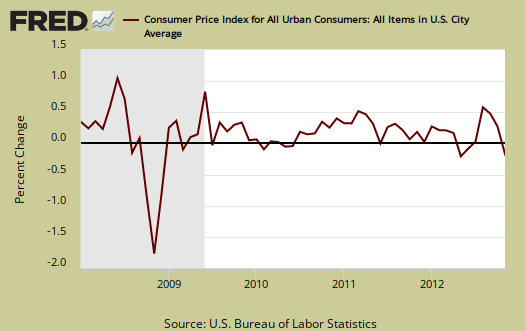
CPI is up 1.8% from a year ago as shown in the below graph.
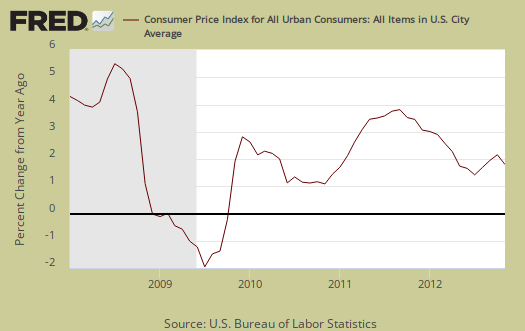
Core inflation, or CPI minus food and energy items, increased 0.1% for November. Core inflation has risen 1.9% for the last year. Core CPI is one of the Federal Reserve inflation watch numbers. These low figures probably helped justify more quantitative easing, which usually increases commodity prices. A global slowdown will trump quantitative easing effect on commodities due to overall weaker demand.
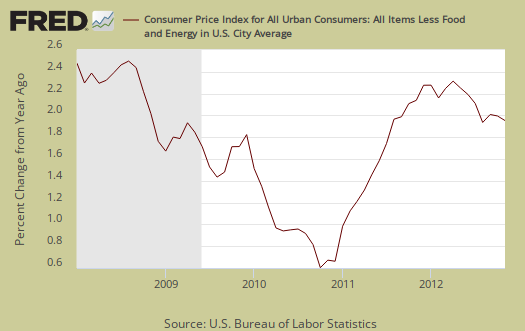
Core CPI's monthly percentage change is graphed below.
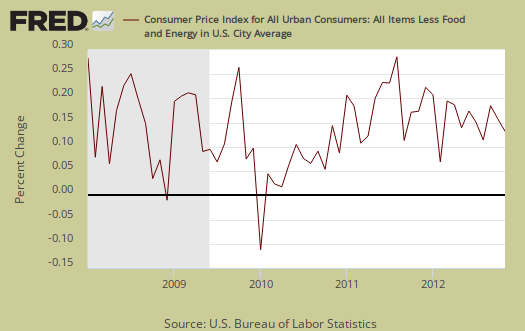
Shelter increased 0.2% and is up 2.2% for the year. The shelter index is comprised of rent, the equivalent cost of owning a home, hotels and motels. Rent increased 0.2%. Used cars and trucks declined -0.5% while apparel dropped -0.6%.
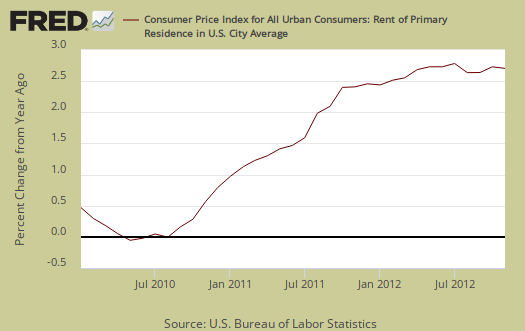
Another cost which never drops is medical care. Medical care services increased 0.3% and has increased 3.7% over the last 12 months. Nowhere else do we see a ridiculous, constant increase in costs.
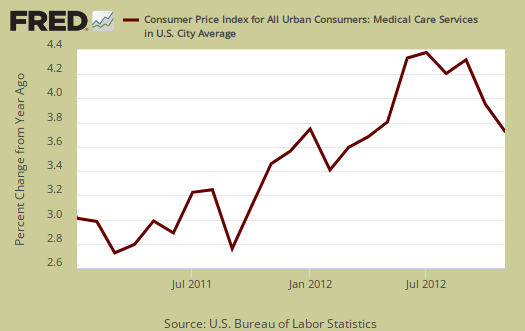
Food and beverages overall increased 0.2% for November and are up 1.8% from a year ago. The food at home index (think groceries) increased 0.3% for the month and is up 1.3% for the year. Eating out, or food away from home increased 0.1% from last month and is up 2.6% from a year ago.
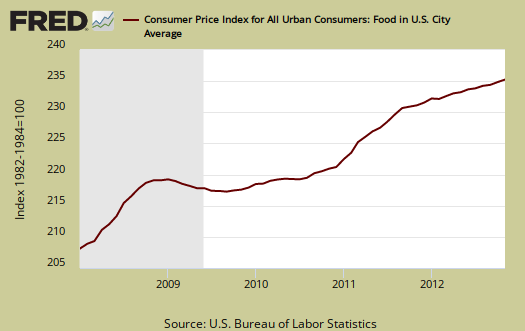
Energy overall decreased -4.1% for November, but is now up 0.3% for the last 12 months. The BLS separates out all energy costs and puts them together into one index. Energy costs are also mixed in with other indexes, such as heating oil for the housing index and gas for the transportation index. Below is the overall CPI energy index, or all things energy.
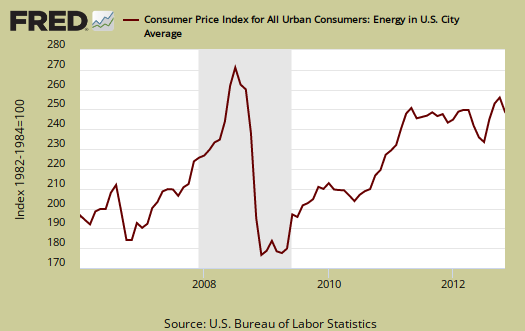
Graphed below is the household energy index which includes electricity and natural gas, shown by monthly percentage change. This month the index increased 0.8% and the reason is natural gas, which jumped 1.3% in November. This is a different, special index to show the overall costs for energy into your home only, (unless you drive your car in your mansion or run generators for your tent).
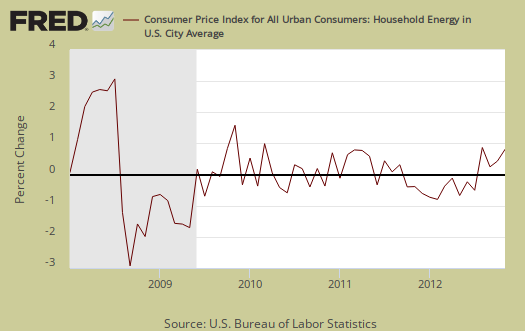
Graphed below is the CPI gasoline index, which declined -7.4% this month and shows just how dependent overall inflation is on gas prices.
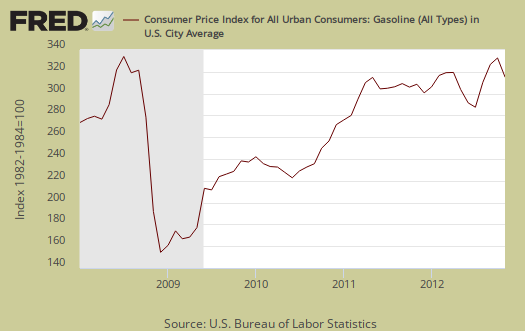
Below are gas prices, last updated December 10th, where gas was $3.349/gal. High oil prices have a strong correlation with recessions.
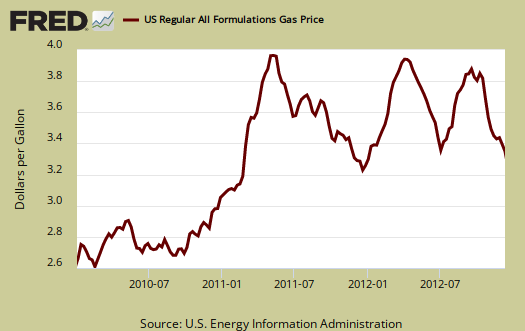
According to the BLS, for the year, food and beverages, which includes food at home, made up 15.2% of the index. Housing is 40.9% and transportation, including gas for the car, is 17.2% and all energy is 10%. Medical care is only 7.1%, they claim. All items minus food and energy are considered 75.8% of the total price expenditures for consumers.
Chained CPI
CPI-W is used to calculate government transfer payments, such as social security increases. The cost of living adjustment (COLA) for social security and other government payments will be 1.7% for 2013.
There is a lot of effort to reduce the social security cost of living adjustments by using chained CPI instead of CPI-W as an inflation index. In a nutshell, chained CPI will lower those cost of living adjustments than using the CPI-W. Below is the not seasonally adjusted monthly difference between chained CPI and CPI-W, as the indexes would be used in the cost of living adjustments. As we can see over time, chained CPI's cumulative effects will be to reduce social security benefits.
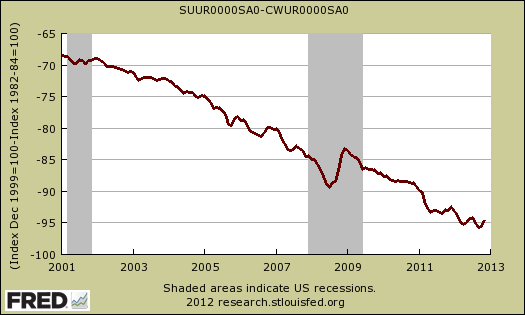
Below is the percent change from one year ago between chained CPI in maroon, against CPI-W in blue. Against we see the percentage increases from one year ago would be less, which means a lower cost of living adjustment for social security.
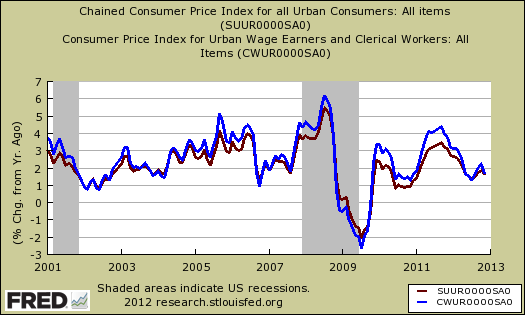
The Consumer Price Index for Urban Wage Earners and Clerical Workers (CPI-W) increased 1.7 percent over the last 12 months to an index level of 226.595 (1982-84=100). For the month, the index decreased 0.6 percent prior to seasonal adjustment.
The Chained Consumer Price Index for All Urban Consumers (C-CPI-U) increased1.6 percent over the last 12 months. For the month, the index decreased 0.4 percent on a not seasonally adjusted basis. Please note that the indexes for the post-2010 period are subject to revision.
Using chained CPI instead of CPI-W is a glorified way to cut benefits. Chained CPI allows for more substitution and with medical costs, there is no substitution for say heart bypass surgery. Substitution is an ongoing controversy in CPI. The claim is when prices on one item skyrocket, the consumer can substitute that item for another. In other words, if steak prices skyrocket, the consumer can start eating chicken or hamburger. This is why the attack on social security is often referred to as cat food, for cat food would be eventually substituted for groceries using chained CPI.
CPI details
The DOL/BLS does take yearly surveys on where the money goes in the monthly budget, but as one can see, food and energy are significant amounts of the monthly finances. Run away costs in these two areas can break the bank, so can food. Additionally CPI uses substitution, so if steak goes through the roof, somehow we're all just fine with hamburger and prices didn't really overall increase much. If we see food inflation flat over the next year, we know something is wrong with the measurement as the drought is projected to dramatically increase food prices.
Last month's CPI report overview, unrevised, although most graphs are updated, is here.
If you're wondering why the graphs look weird, the graph calculates percentages from the index and doesn't round. The actual data from the BLS report does round to one decimal place. In other words, 0.05% is rounded to 0.1%.

Recent comments